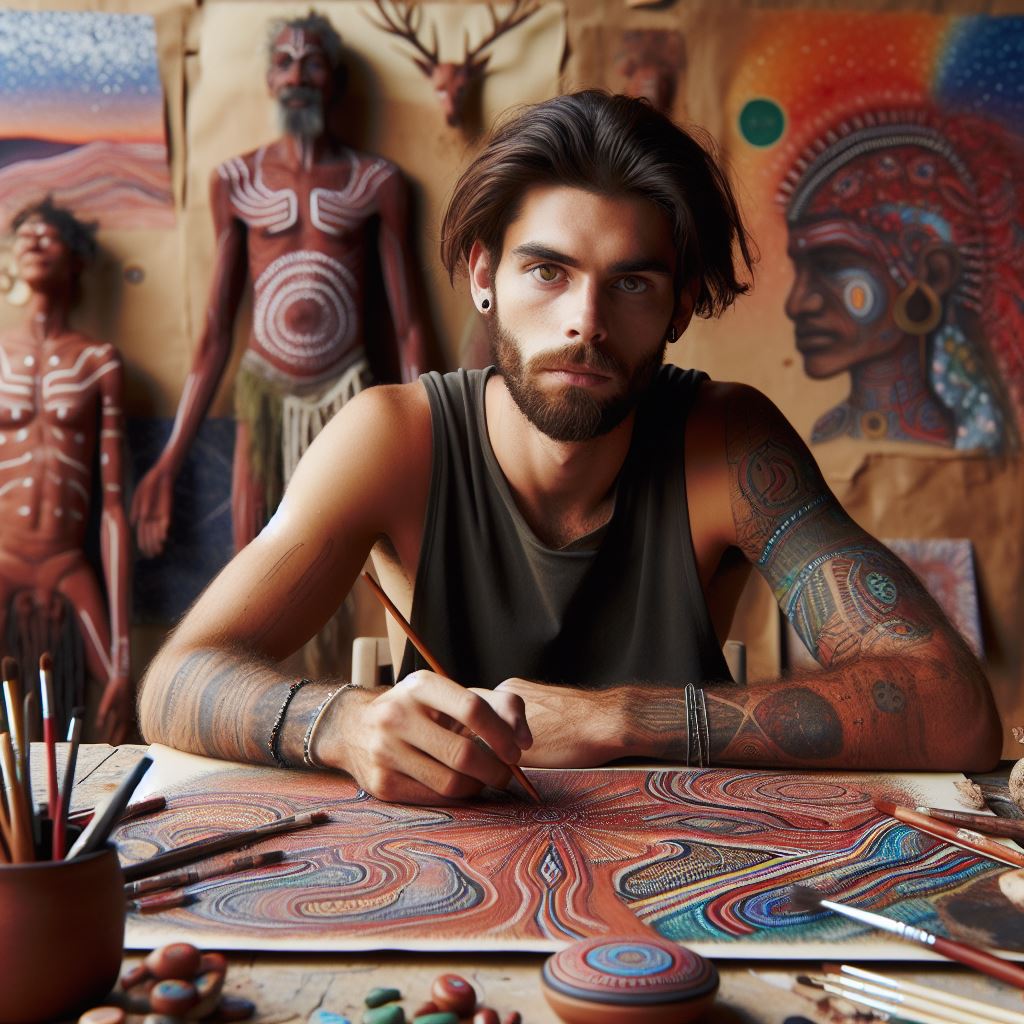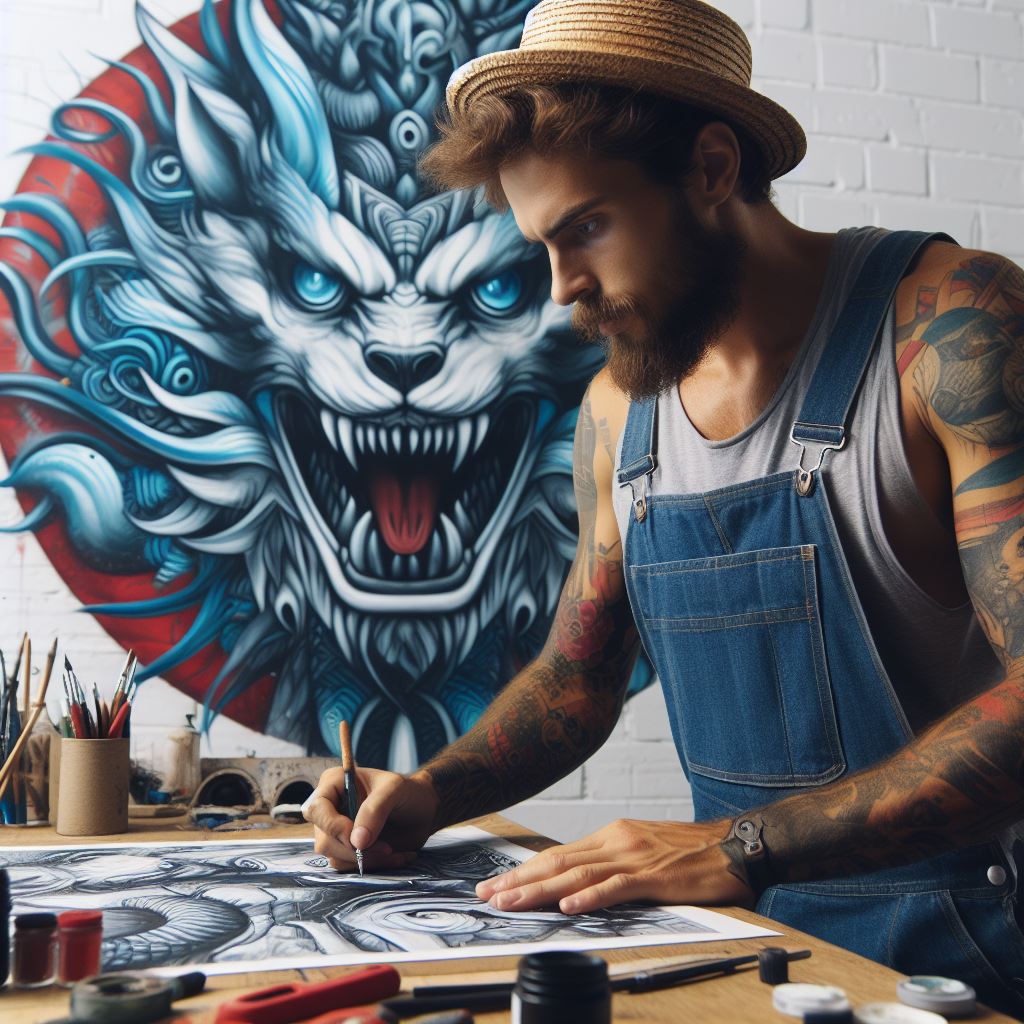Introduction
Embarking on a Cultural Journey: The Dynamic Evolution and Lasting Influence of Aboriginal Art in Australia
Dive into the rich tapestry of Aboriginal art, a cultural phenomenon that has profoundly impacted Australia.
From ancient rock paintings to contemporary masterpieces, this section explores the evolution and enduring influence of Aboriginal artistic expressions.
Discover the vibrant stories, symbols, and techniques that have shaped not only the artistic landscape but also the cultural identity of Australia’s Indigenous peoples.
Join us on this visual odyssey as we unravel the threads of history woven through the canvas of Aboriginal art, witnessing its transformative journey through time.
Aboriginal art is a unique artistic expression that holds great importance and cultural significance in Australia. This blog post explores the influence and evolution of Aboriginal art within the country.
Aboriginal art
Aboriginal art is an intricate and ancient form of artistic expression native to Australia.
It is deeply rooted in the rich indigenous cultures and traditions of the Aboriginal people.
These artworks serve as a powerful medium for storytelling, cultural preservation, and spiritual representation.
The importance of Aboriginal art lies in its ability to convey significant cultural knowledge and identity.
These artworks often depict spiritual and ancestral connections, traditional ceremonies, and the relationship between humans and nature.
Aboriginal art has evolved over thousands of years, adapting to changing artistic styles and techniques.
Historically, this art form was primarily painted on rocks, cave walls, and ceremonial objects.
With the arrival of Europeans, Aboriginal art began to include materials such as canvas, paints, and brushes.
This shift allowed Aboriginal artists to showcase their art to a wider audience and resulted in the emergence of a contemporary Aboriginal art movement.
Today, Aboriginal art can be found in galleries and exhibitions worldwide, showcasing the diverse styles and stories of Aboriginal artists.
Ultimately, Aboriginal art is a crucial part of Australian culture and heritage. Its influence and evolution have shaped the artistic landscape of the country, while also preserving the rich Indigenous traditions and stories for future generations.
Brief history of Aboriginal art
Aboriginal art spans millennia, with rock paintings and engravings capturing stories and spiritual beliefs in intricate detail.
Your Personalized Career Strategy
Unlock your potential with tailored career consulting. Get clear, actionable steps designed for your success. Start now!
Get StartedIndigenous tribes preserved history through art, fostering a connection between storytelling, spirituality, and cultural knowledge.
Natural materials like ochre pigments, derived from minerals and clay, characterized early Aboriginal art, enduring Australia’s harsh climate.
European settlers introduced oil paints, acrylics, and canvas, expanding possibilities for Aboriginal artists and ushering in experimentation.
Today, Aboriginal art seamlessly blends tradition and modernity, incorporating acrylic paints and canvas into its evolving forms.
This fusion has propelled Aboriginal art to global recognition, with indigenous artists achieving international acclaim and addressing community issues.
Aboriginal art serves as a potent cultural preserver, allowing future generations to connect with their heritage’s resilience and creativity.
As Aboriginal art evolves, it remains a vital component of Australia’s cultural identity, requiring continued appreciation and support.
Read: Australian Music Awards: A Closer Look
Influence of Aboriginal art on Western art
- Discovery and appreciation of Aboriginal art by non-Aboriginal artists.
- Influence on modern art movements, such as Cubism and Abstract Expressionism.
- Exploration of Aboriginal art techniques and motifs by Western artists.
Discovery and appreciation of Aboriginal art by non-Aboriginal artists
Aboriginal art has had a profound influence on Western art, leading to the discovery and appreciation of its unique beauty and cultural significance by non-Aboriginal artists.
Influence on modern art movements, such as Cubism and Abstract Expressionism
One of the key impacts of Aboriginal art on Western art is its influence on various modern art movements. Aboriginal art, with its focus on shapes, patterns, and symbols, played a significant role in the development of Cubism, a movement that revolutionized Western art in the early 20th century.
Artists like Pablo Picasso and Georges Braque were inspired by the simplicity and abstraction found in Aboriginal art, leading to the fragmentation of forms and multiple perspectives evident in Cubist artwork.
Furthermore, Aboriginal art also had a strong impact on Abstract Expressionism, a post-World War II movement that emphasized emotional expression through non-representational forms.
Artists like Jackson Pollock and Mark Rothko were captivated by the spiritual and symbolic elements of Aboriginal art, incorporating its concepts of storytelling and connection to land into their own artwork.
This integration of Aboriginal motifs and techniques into Western art helped shape the direction of Abstract Expressionism and expanded the artistic vocabulary of Western artists.
Exploration of Aboriginal art techniques and motifs by Western artists
Western artists have also explored Aboriginal art techniques and motifs directly, seeking to understand and learn from Indigenous artistic practices.
This cross-cultural exchange has enriched the Western art world and allowed for the creation of unique works that blend Western and Aboriginal artistic traditions.
Artists like Emily Kame Kngwarreye and Clifford Possum Tjapaltjarri have gained recognition for their fusion of traditional Indigenous techniques, such as dot painting, with Western artistic concepts.
The appreciation and integration of Aboriginal art into Western art have not only influenced artistic movements and techniques but also fostered a greater cultural understanding and appreciation of Indigenous Australian culture.
This increased awareness has led to the preservation and promotion of Aboriginal art, allowing it to thrive and continue to evolve.
Basically, the influence of Aboriginal art on Western art cannot be understated. From inspiring modern art movements to direct exploration of techniques and motifs, Aboriginal art has made a lasting impact on the artistic world.
Its integration has not only enriched Western art but also facilitated a deeper appreciation and understanding of Indigenous Australian culture.
Stand Out with a Resume That Gets Results
Your career is worth more than a generic template. Let us craft a resume and cover letter that showcase your unique strengths and help you secure that dream job.
Get HiredRead: Building a Music Career in Australia
Find Out More: Directing Commercials in Australia: A Guide
Evolution of Aboriginal art
Aboriginal art has evolved significantly over the years, influenced by various factors including colonization, the introduction of new mediums and materials, and the emergence of contemporary Aboriginal art styles and artists.
This evolution has led to the incorporation of new themes and concepts in Aboriginal art, reflecting the changing times and cultural influences.
The impact of colonization on Aboriginal art
- Colonization had a profound impact on Aboriginal art, interrupting traditional forms of artistic expression.
- Prohibitions and discouragement led to a decline in producing traditional Aboriginal art, impacting various art practices.
- Despite these challenges, Aboriginal artists often found ways to preserve and pass down their cultural heritage through art.
- The introduction of new artistic techniques and materials by European settlers also influenced Aboriginal art.
Adapting traditional art forms to new mediums and materials
- Aboriginal artists embraced new mediums and materials, incorporating them into traditional art forms.
- Canvas, acrylic paint, and paper became popular alternatives to bark, ochre, and rock surfaces.
- This adaptation allowed Aboriginal artists to reach a broader audience and preserve their cultural heritage in new ways.
Emergence of contemporary Aboriginal art styles and artists
- The late 20th century saw the emergence of contemporary Aboriginal art styles and artists.
- These artists combined traditional Aboriginal art techniques with modern influences and personal experiences.
- Contemporary Aboriginal art became highly sought after in the global art market, raising awareness of Indigenous culture and issues.
- Artists like Emily Kame Kngwarreye and Clifford Possum Tjapaltjarri gained international recognition for their innovative work.
Incorporation of new themes and concepts in Aboriginal art
- Aboriginal art started to explore new themes and concepts, reflecting the changing social and political landscape.
- Issues like land rights, identity, and the Stolen Generations were depicted in paintings and sculptures.
- The incorporation of these new themes broadened the narrative of Aboriginal art and fostered important conversations.
Colonization, new mediums, contemporary styles, and new themes have influenced the evolution of Aboriginal art over time.
This ongoing evolution ensures that Aboriginal art remains a vibrant and relevant expression of Indigenous culture and identity.
Read: Music Production: A Guide for Aussies

Recognition and Appreciation of Aboriginal Art
Aboriginal art holds a significant place in Australian history and culture. The unique artistic expressions of Indigenous Australians are represented, carrying stories and traditions passed down for generations.
The recognition and appreciation of Aboriginal art have become crucial in preserving and promoting their cultural heritage.
Efforts to Preserve and Promote Aboriginal Art and Cultural Heritage
- Government initiatives: Various government bodies have taken steps to support and preserve Aboriginal art. These include providing funding for art centers, galleries, and cultural programs.
- Cultural institutions: Museums and galleries play a vital role in showcasing and preserving Aboriginal art. They collaborate with Indigenous communities, ensuring their cultural protocols are respected.
- Art centers and community projects: Aboriginal art centers serve as important platforms for artists to create, exhibit, and sell their artworks. They also offer skills development programs to nurture artistic talent.
- Indigenous-owned galleries: These galleries focus on showcasing exclusively Indigenous art, ensuring the artworks are ethically sourced and supporting the artists directly.
Growing Appreciation and Demand for Aboriginal Art Globally
Aboriginal art has gained international recognition and appreciation over the years. Its unique style, connection to the land, and rich cultural significance have captivated art enthusiasts worldwide. As a result, the demand for Aboriginal art has soared globally.
- Exhibitions and art fairs: Australian Aboriginal art is regularly exhibited at prestigious exhibitions and art fairs around the world. This exposure helps promote greater understanding and recognition of the art form.
- Global collaborations: Indigenous artists engage in collaborations with international artists, resulting in unique cross-cultural artworks that merge traditional Aboriginal techniques with contemporary influences.
- Online platforms: The internet has played a significant role in expanding the reach of Aboriginal art. Online galleries and social media platforms allow artists to showcase and sell their works globally.
- Cultural tourism: Aboriginal art has become a significant attraction for tourists visiting Australia. Indigenous cultural experiences, including art workshops and guided tours, provide visitors with an opportunity to appreciate and learn about the art form.
Importance of Supporting and Respecting Aboriginal Artists and Their Communities
Supporting and respecting Aboriginal artists and their communities is crucial for the preservation and continuation of their art and cultural practices. It is essential to acknowledge the significance of Aboriginal art and the rights of Indigenous artists.
- Fair payment and recognition: Aboriginal artists deserve fair payment and recognition for their work. It is important to purchase artworks through authorized channels and ensure that artists receive a fair share of the profits.
- Cultural protocols: Aboriginal art is deeply intertwined with cultural protocols, including restrictions on reproducing certain artworks. Respecting these protocols helps protect sacred knowledge and ensures the cultural integrity of the art.
- Education and awareness: Promoting education and awareness about Aboriginal art and culture fosters a deeper understanding and appreciation.
This includes educating the public about cultural appropriation and the significance of appropriate use of Indigenous symbols and designs. - Economic empowerment: Supporting the Aboriginal art industry contributes to the economic empowerment of Indigenous communities. Buying and promoting artworks directly from artists and Indigenous-owned galleries helps create sustainable livelihoods.
Essence, the recognition and appreciation of Aboriginal art are essential in preserving and promoting Indigenous cultural heritage.
Efforts to maintain and showcase Aboriginal art, the growing global appreciation, and the importance of supporting and respecting Aboriginal artists are crucial in ensuring the continuation and vitality of this unique art form.
Read: How to Network in Australia’s Music Scene
Conclusion
The influence and evolution of Aboriginal art
Overall, the influence and evolution of Aboriginal art have had a profound impact on both indigenous communities and the wider art world. Aboriginal art forms have a rich cultural significance that must be preserved and celebrated.
By telling stories, preserving traditions, and connecting to the land, Aboriginal art serves as a testament to the enduring spirit and resilience of Indigenous cultures. It is a powerful tool for cultural preservation and identity.
The cultural significance and importance of preserving Aboriginal art forms
The ongoing influence and future of Aboriginal art in Australia and beyond are promising. As more people become aware of its beauty and cultural significance, there is a growing appreciation for this unique art form.
Closing thoughts on the ongoing influence and future of Aboriginal art in Australia and beyond
With global recognition and demand for Aboriginal art increasing, there are concerns about cultural appropriation and exploitation. Ensure protection and respect for Aboriginal artists. Accurately represent their stories and cultural heritage to uphold their dignity.
Transform Your LinkedIn for Maximum Impact
Elevate your professional brand with a LinkedIn profile that attracts recruiters, showcases your expertise, and maximizes opportunities. Stand out in your industry with a profile built for success.
Boost ProfileProtect and celebrate Aboriginal art, as it is not merely a visual representation but a manifestation of stories and identities.
Its evolution and ongoing influence solidify its importance, not only in Australia but also around the world. By preserving Aboriginal art, we honor and respect the rich cultural heritage it represents.




